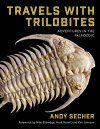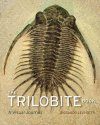By
Leon (NHBS Catalogue Editor)
28 Sep 2022
Written for Hardback

Given my academic background, I often overlook the fact that fossils are not just objects of scientific study, but also sought-after collectables. While the previously reviewed
Trilobite! by Richard Fortey focused on the former aspect,
Travels with Trilobites combines an enthusiastic insider's perspective of the world of trilobite collectors with photography of his extensive collection. This, then, is the second of a two-part dive into the world of that most enigmatic extinct creature: the trilobite.
Fossil collectors come from all walks of life. Andy Secher previously edited the hard rock magazine
Hit Parader but later in life collecting trilobite fossils became his main passion and he is now a field associate in palaeontology with the AMNH. Having amassed over 4000 fossils, he ranks as one of the world's most prolific collectors. As the three forewords reveal, he is keen to share his collection with the wider world. He has provided the AMNH with important specimens for study and display, and co-edits their trilobite website which laid the groundwork for this book.
Secher is straightforward about the book's aim: this is "a package of pure Paleozoic infotainment" (p. xxix) that takes the reader on a journey around the world to some of the most important fossil localities. The book is organised chronologically, with five chapters for the six geological periods making up the Palaeozoic Era, 541–252 million years ago. Each chapter contains multiple self-contained sections, which introduces some repetition but means the book can be read in any order.
The biology and palaeontology of trilobites are covered in short essays that are sprinkled throughout the book in no particular order and without an overarching narrative. This covers such diverse topics as their unique calcite eyes and the spines that were only properly revealed when preparation techniques improved. It covers behaviours for which we have fossil evidence (moulting and enrollment) and those for which we can only speculate (feeding behaviour or terrestrial locomotion on tidal flats). And there is of course their part in the Cambrian Explosion,plate tectonics, and punctuated equilibrium. For those new to trilobites, there is interesting information here, though having read Fortey's book I found only a few new ideas. The book furthermore includes no references, though given the book's stated aim and the author's background, you could argue there is no reason to expect them.
Instead, the backbone of this book is the essays that introduce you to key fossil locations. This is where Secher shines and gives insider stories and insights by himself and other seasoned collectors. He introduces famous locations such as the Canadian Burgess Shale and the Chinese Chengjiang Biota, and lesser-known ones: Australia's Emu Bay Shale which sits between the previous two in age, Portugal's Valongo Formation that has yielded giant trilobites, or Quebec's hard-to-reach Anticosti Island. He takes you to hotspots in Russia and Morocco and describes in detail how local collectors go about unearthing fossils. With Secher hailing from the US, plenty of North American locations get a good look-in. For some quarries, such as the Walcott/Rust Quarry in New York where the legendary Charles Doolittle Walcott dug for fossils, he can tell the full history from 1860 to now. Elsewhere he introduces you to some of today's veterans, such as Bob Carroll, who single-handedly put Oklahoma's Haragan Formation on the map and is legendary for his fossil preparation skills.
It is clear that the book benefits from the chronological structure Secher has imposed upon himself because the moment it disappears the book meanders somewhat. The final chapter is aptly called "Trilobite Thoughts and Observations" with various musings on collectors and collecting. He ponders how to find trilobites, how to value them, and how to curate your collection. He describes the bazaar atmosphere of fossil shows, celebrates the work of fossil preparators, lists the museums with the best trilobite collections, and talks of colour patterns, deep time, and the role of trilobites in history. And though he touches on sore points such as legislation banning export of fossils or the problem of fossil forgery in Morocco and Russia, I found such sections somewhat superficial. Many important topics are briefly introduced, but none are exhaustively or objectively analysed. With 17 topics over 70 pages, this chapter could have been edited for length and focus. Or the best topics could have been incorporated in the first five chapters instead, where e.g. forgery is already mentioned.
The essays are livened up by some 300 colour photos, primarily of specimens from Secher's own collection. These are intended to show the incredible diversity of trilobite form. Though Secher has attempted to tie them to the subjects and locations discussed, many noteworthy pictures were left while compiling the book. He has cleverly resorted to including a photo gallery at the end of each chapter to accommodate these. Now, Secher's collection and the selected specimens are jaw-dropping. My mental image of what a trilobite can look like has been completely scrambled and reset. However, this is let down somewhat by the quality of the photos, which is a shame as the book's large format clearly suggests this is a book to be enjoyed for its visual content. I am not talking about the 18 photos in chapter six that are visibly pixelated: this looks like an honest if embarrassing mistake. Instead, many images of especially smaller fossils look somewhat blurry. Since no photographer is mentioned or credited anywhere, I can only assume these are Secher's own photos. My guess is that he made close-up photos using digital zoom, which simply crops and upscales the photo and is unsuitable for print reproduction at large sizes. The book would have benefited from the involvement of a professional (macro)photographer, ideally someone familiar with focus stacking to let the pictures of three-dimensionally preserved fossils pop (these are now also partially out of focus).
Some of you might wonder how, this book compares to the
The Trilobite Book from 2014 that had a similar approach though was organised geographically. Having leafed through it, the quality of the photography is noticeably better. Especially if you already have that book, you might want to first peruse a copy of
Travels with Trilobites in a bookshop to make up your mind. I enjoyed Secher's enthusiasm and the perspective he provides into a world I was not familiar with. Even so, I could not help but feel that some opportunities were missed to really make this book shine.












































